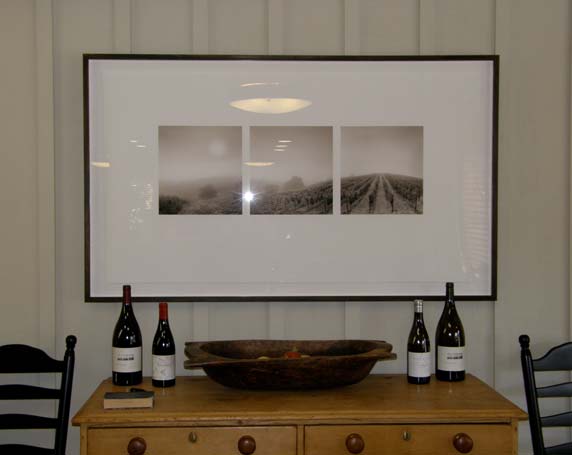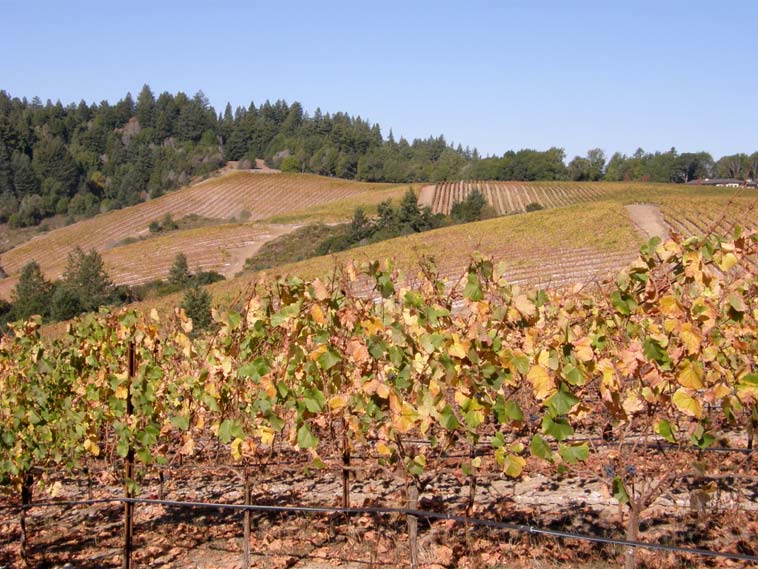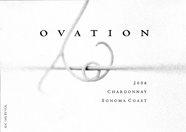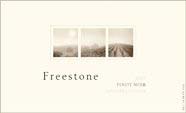Freestone Vineyards
Growing Pinot Noir along the most western reaches of the Sonoma Coast is a risky undertaking. The region is
extremely cool and there is the constant threat of rain during bloom and harvest. Yields can be excruciatingly
and unprofitably small, in some vintages totaling a 1/2 ton per acre, and in others, amounting to no commercially
viable crop at all. The terrain is rugged and much of the land is inhospitable and unsuitable for vines.
Gophers, birds, deer, and wild hogs are in abundance. Despite these obstacles, a dedicated few have
accepted the challenge knowing that the fickle grape feels right at home here. Noted wine writer, Matt Kramer,
has said, “One thing is already clear: Sonoma Coast West is an extraordinary location for Pinot Noir. Sonoma
Coast West has the capacity - although not yet the achievement - of someday creating America’s grand cru
Pinot Noirs.”
The Sonoma Coast appellation (AVA) is the largest of the thirteen AVAs in Sonoma County at 750 square miles.
This unwieldy appellation was formed in 1987 and includes an endless number of microclimates all typified by
coolness. The Sonoma Coast AVA was primarily created to allow certain wineries to include all of their diverse
vineyard holdings within one appellation so they could use the “estate bottled” designation on their wine labels.
The Sonoma Coast AVA extends from the Sonoma County border with Napa Carneros to the East, to Marin
County to the South, to the Pacific Ocean to the West, and to the Sonoma County border with Mendocino
County in the North (see below).
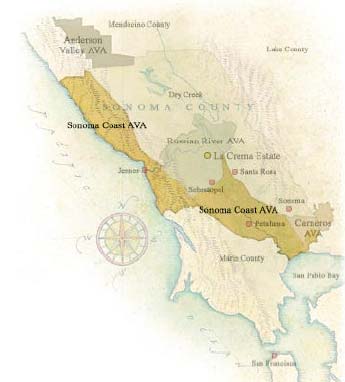
Because of the immensity of the Sonoma Coast AVA, an unofficial subdivision has been created termed the
“true” Sonoma Coast (what Matt Kramer calls Sonoma Coast West). This subdivision is roughly from Jenner in
the South where the Russian River empties into the Pacific Ocean, to Annapolis in the North, and from the beaches to 5 to 6 miles inland including the first two ridges of the Coastal Range of mountains and the western
slope of the third ridge. Besides Annapolis and Jenner, Ft. Ross, Occidental and Freestone are included,
although all are south of Jenner. At some point in the future, the true Sonoma Coast will be broken into smaller
AVAs.
Freestone Vineyards was not the first to plant Pinot Noir in the true Sonoma Coast. That honor goes to Mike
Bohan. In 1973, he developed a vineyard on Bohan Dillon Road which included Zinfandel, Pinot Noir,
Chardonnay and Riesling. Many others soon followed, notably David Hirsch (Hirsch Vineyard) and Walt and
Joan Flowers (Camp Meeting Ridge), but also Helen Turley and John Wetlaufer (Marcassin), Lee Martinelli
(Martinelli), Bill Smith (W.H.Smith), Daniel and Marian Schoenfeld (Wild Hog), Mark Bixler and Steve Kistler
(Kistler Vineyards) and Marimar Torres (Marimar Estate). More recently, several prominent Napa wineries
have developed vineyards in the true Sonoma Coast, including Caymus (Belle Glos), Pahlmeyer, Peter Michael
and Joseph Phelps (Freestone Vineyards). Freestone Vineyards is clearly the most ambitious project and the
only Napan producer to establish a winery and guest center in the true Sonoma Coast.
The town of Freestone dates to the Gold Rush era in California, a time when Pinot Noir first arrived in
California from cuttings imported by either Frenchman Pierre Pellier, Hungarian Colonel Agoston Haraszthy, or
Frenchman Charles Lefranc. Freestone was named in 1853 after a quarry of sandstone in the area. The first
white settlers in this area, James McIntosh, James Dawson and James Black, were sent by General Vallejo to
settle the land near Freestone in the mid 1800s. The settlement was part of the Mexican government’s attempt
to extend Mexico’s frontier in Sonoma County north toward the Russian settlement at Ft. Ross. By 1872,
Freestone had become a terminus for the North Pacific Railroad and a trade center for the area. The photo
below shows the North Pacific Coast Railroad’s Freestone Station as it looked in the 1900s.
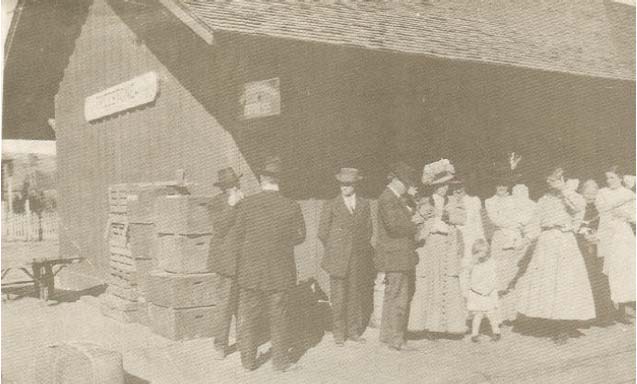
The once-thriving lumber industry eventually dwindled and the railroad was abandoned. This tiny town still has
the original 1887 school house and the post office operates in what was originally the town’s general store. In
1974, Freestone was declared a historical district by the citizenry of Sonoma County. Freestone has become
known mainly for two businesses. The Wild Flour Bakery at the intersection of the Bohemian Highway and
Highway 12 bakes breads in a wood-fired brick oven that are among the best in Northern California. The
nearby Osmosis is a world-renowned healing sanctuary and spa in a Japanese-style setting on five acres.
Freestone Vineyards has brought new life to this sleepy town and undoubtedly will attract visitors who are
curious about this westernmost frontier of Sonoma County Pinot Noir country. The Joseph Phelps organization
has built a magnificent 40,000 square foot winery at the end of Freestone Flat Road. Bermed into the hillside
and employing gravity-flow by way of its three level construction, it sits in the center of the estate Freestone
Vineyard. Unfortunately, environmental concerns prevent tastings and tours at the winery, so Freestone
Vineyards has opened an attractive and comfortable guest center at the corner of Bohemian Highway and
Highway 12 in the historic Pastorale Building which was formerly a woolens store (see photo below). The
inviting space is furnished in country French furniture and offers the visitors an appealing copper-topped bar or
a spacious table to sit and linger. The entire project initially met with some resistance from local residents, but
Freestone Vineyards has proven to them to be committed to being an attentive caretaker of this historically rich
area.
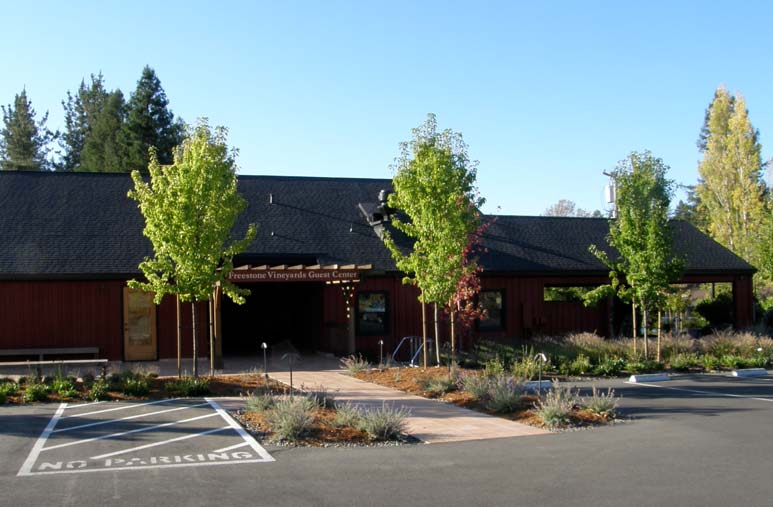
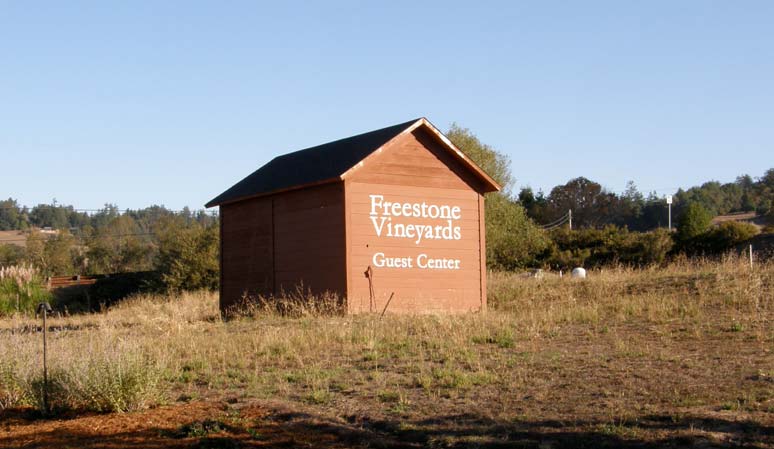
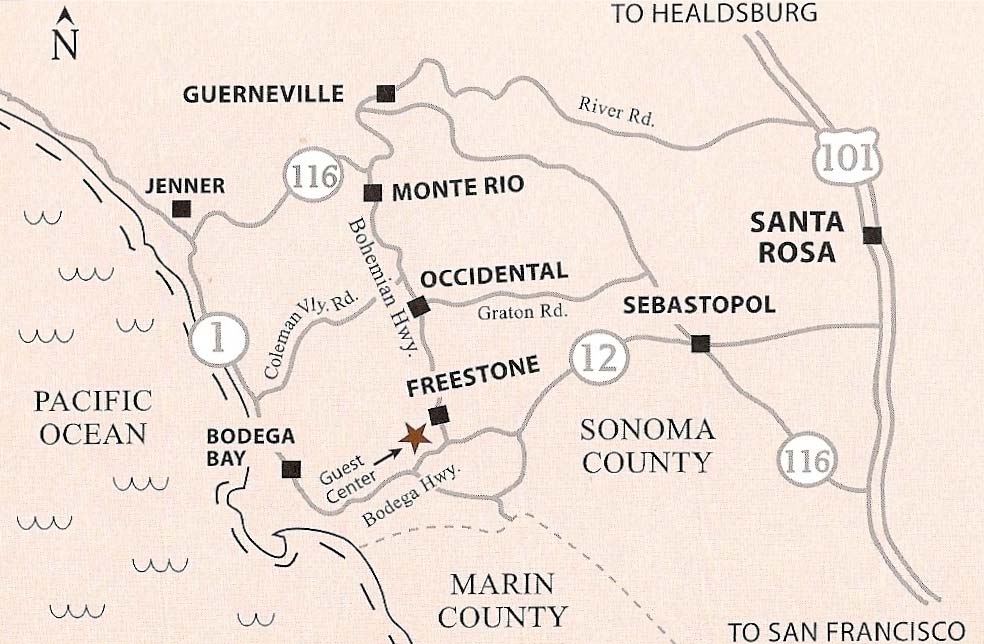
I visited Freestone Vineyards on a brilliantly sunny day in late October. Harvest had concluded but the vines
were bursting with vibrant colors of orange and yellow, a striking contrast to the hillsides covered with towering
redwood trees. I was met by a warm and enthusiastic staff, eager to show off their beautiful vineyard setting,
modern winery, and superb wines. An impressive team has been assembled. Joel Robledo is the Vineyard
Surpervisor, a veteran of 13 years in Knights Valley for Beringer and 3 years in Sonoma County for Joseph
Phelps Vineyards. Vineyard Operations Manager Greg Cannon has experience working at numerous wineries
in California and South Africa and has been at Joseph Phelps Vineyards since 1994. He has prime upstairs
office space overlooking Pastorale Vineyard (the portion of Freestone Vineyard next to the winery and business
center). The Cellar Master is Justin Ennis, a veteran of Williams Selyem Winery in Healdsburg, Villa Maria
Winery in New Zealand and Vinas de Tupangato in Argentina. The winemaking team consists of Director of
Winemaking Damian Parker, who has been with Joseph Phelps Vineyards since 1981 and Associate
Winemaker Theresa Heredia. Theresa has an impressive educational resume, with a Bachelor’s degree in
Biochemistry from Cal Poly in San Luis Obispo, and three years of study in the Chemistry and Viticulture/
Enology program at University of California Davis. Her winemaking experience includes time spent at
Saintsbury in Napa Carneros and Burgundy. She joined Joseph Phelps Vineyards in 2002. This is a
compatible pairing (the two are pictured below at the estate Quarter Moon Vineyard), with Damian providing
the steadying and experienced hand and Theresia contributing the innovative enthusiasm of youth. Pascal
Marchand, an internationally acclaimed winemaker and former manager of Domaine de la Vougeraie and the
estate of Comte Armand, Domaine des Epeneaux, has brought his expertise as a consultant as well.
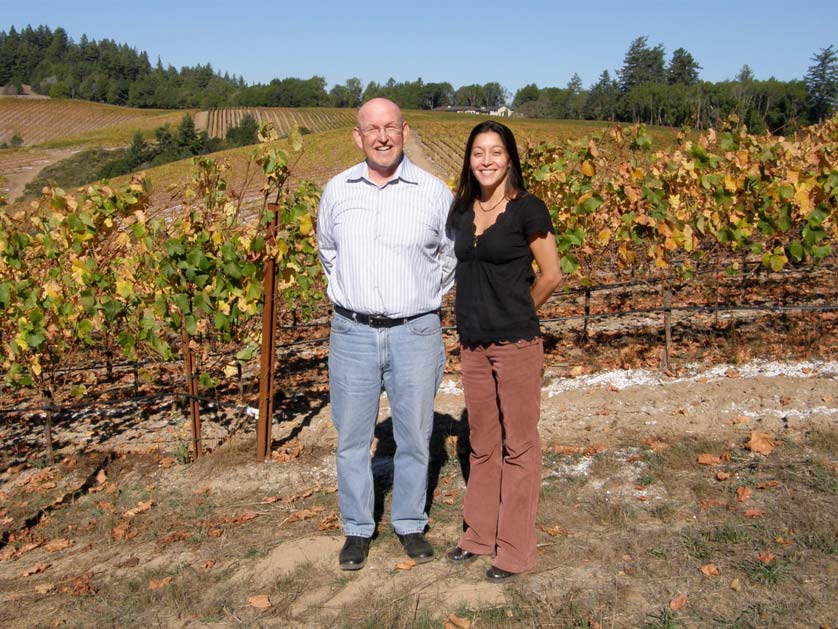
Freestone Vineyards dates to 1999, when Joseph Phelps, his son Bill and the Phelps
management team bought 55 acres in Freestone on Freestone Flat Road. Joseph Phelps,
who was fond of Chardonnay, had yearned for an appropriate location to establish a new
Chardonnay program. His popular Joseph Phelps Ovation Chardonnay was sourced from
vineyards in Carneros. The Freestone property, which in the past had been used for
logging, dairy farming and even a rest home, was also a perfect locale for Pinot Noir. In
2000, additional nearby land was acquired including Quail Hill Ranch (renamed Quarter
Moon Vineyard).
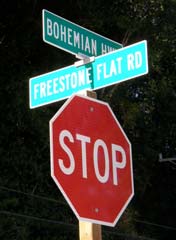
Planting began in 1999, divided among two sites. Freestone Vineyard consists of 60 acres
of Pinot Noir and 20 acres of Chardonnay planted at elevations of 200 to 500 feet. This
vineyard is divided into a north and south portion with most of the entire vineyard planted to 4’ x 4’ spacing. There is a diversified mix of rootstocks and clones (Calera and Swan selections, Dijon 115,
667, 777, 828 and the rarely planted 459). Generally, different blocks from this vineyard are vinified separately
rather than isolating different clones and selections. Whole cluster fermentation is employed for blocks that are
particularly suitable. The Freestone Vineyard and winery are pictured below with the North portion in the
foreground and the South portion (recently named Pastorale Vineyard) in the distance surrounding the winery.
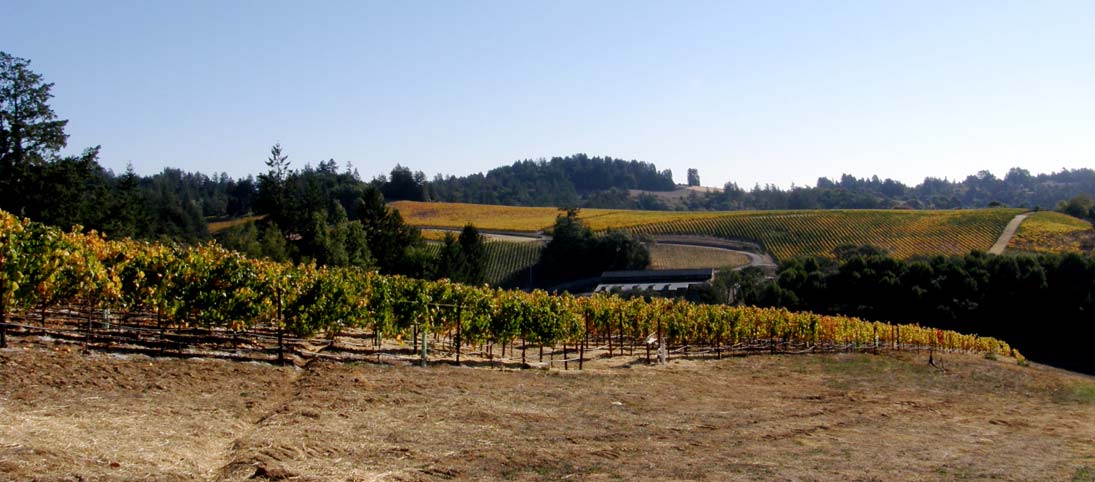
The nearby Quarter Moon Vineyard is located on the western side of Bohemian Highway and is planted to 40
acres of Pinot Noir. At 400 foot elevation at its highest, this vineyard lies above the fog line, facing south, and
sits about five miles from the Pacific Ocean. It is in proximity to vineyards owned by Benziger and Kistler and
is a magnificent site as you can see in the photo below. The plantings at Quarter Moon Vineyard include
heritage selections (primarily Calera) as well as Dijon 115, 777 and 828.
A third vineyard source, the Ferguson Vineyard, consists of six acres of Pinot Noir planted to Dijon clone 115.
The fruit is sourced under a 30-year lease from the owners.
All the vineyards are exposed to chilly maritime air with low-lying morning fog giving way to afternoon sunshine.
Temperature swings of 45 degrees are not unusual and the cool days of the spring growing season can lead to
low berry set. Farming here is not for the faint-of-heart. Soils are Goldridge Series with excellent drainage.
Roots grow deeply searching for nutrients, allowing some vineyard blocks to be dry farmed. Ultimately, it is
hoped that all Freestone vineyards will be dry farmed and managed biodynamically. Controlling weeds and
gophers continues to be an “uphill battle” as Theresia notes, and requires constant vigilance.
The modern winery, completed in time for the 2007 harvest, is a state-of-the-art, gravity-flow facility enabling
the winemaking staff to perform at the highest level. Designed by architect Paul Smith, who created the design
at Byron Winery in the Central Coast, the winery was built by Hansel Phelps Construction in Colorado. Joseph
Phelp’s father, Hensel, founded this company in 1937 and Joseph ran it for many years before departing to
enter the wine industry in the early 1970s. The winery’s hillside location and compatible exterior blends
perfectly into the wooded location. Inside, the facility is all concrete, stainless steel and copper, and roomy
enough to be highly efficient. An industrial lift provides easy movement of winery equipment and byproducts of
winemaking between the three levels. On the upper floor, a refrigerated holding room keeps incoming bins of
fruit cold so that bright fruit flavors and acidity are retained before processing. Cold grapes can also be destemmed
more readily. The center level houses 35 4 1/2- to 7-ton stainless steel fermenting tanks. Five wood
tank fermenters permit more focused winemaking for primarily the vineyard designate bottlings. The lower
level features separate temperature-controlled barrel rooms for Chardonnay and Pinot Noir.
Winemaking with Freestone fruit is still evolving. The vines are very young and 2006 is the first large-scale
commercial vintage. In 2002 and 2003, a few barrels of wine were produced and in 2004 and 2005, a FogDog
Pinot Noir blended from grapes from the three estate-grown vineyards was released. Theresa noted that
tannin management has been one of her major focuses since the Freestone grapes typically show sturdy
tannin development. Noted winemaker Ted Lemon has characterized true Sonoma Coast Pinot Noir as,
“Muscle and sinew, grit, structure, more backbone and tannin than Russian River Valley Pinot Noir.” Theresa
has adjusted stem inclusion, maceration, the temperature of fermentation, and the pigeage regimen searching
for the ideal combination to soften tannins. Currently, she is incorporating more stems, macerating and
fermenting at a higher must temperature, extending maceration, and adding two punch overs a day to the
punch down program. The oak regimen calls for light to medium toasted French oak barrels and 40-60% new
oak, with the highest proportion of new oak reserved for the vineyard-designate Pinot Noirs. Filtration is
avoided completely and fining is employed only rarely.
At the winery, I tasted the 2006 Fogdog and 2006 Freestone Pinot Noirs, which are now in release, and two
vineyard-designates, the 2007 Quarter Moon Vineyard and 2007 Pastorale Vineyard Pinot Noirs, scheduled for
future release. The 2006 Pinot Noirs along with the Chardonnay lineup were re-tasted in my usual setting at
home. The Chardonnay program is on equal footing qualitatively with the Pinot Noirs. The true Sonoma Coast
has not received the same recognition for Chardonnay as for Pinot Noir but considerable potential has been
shown by releases from Hirsch, Marcassin, Sonoma Coast Vineyards and now Freestone Vineyards. Given the
impressive wine program at Freestone Vineyards, and the considerable financial backing, I was not surprised
to find the entire lineup of wines stellar. However, the wines exceeded my expectations and I believe this new
producer is poised for greatness. The wines of Freestone Vineyards are confirmation that Matt Kramer’s quote
is not just hyperbole.
The 2006 vintage on the Sonoma Coast was characterized by rain and plenty of it (more than 9 feet). The
result was an extended growing season with late but adequate ripening.
2007 Freestone Vineyards Pastorale Vineyard Sonoma Coast Pinot Noir
14.0% alc., 50 cases, $90-$100
when released. Wood tank and whole cluster fermented, aged in 60% new French oak. 98% Calera selection
from the Pastorale Vineyard (formerly part of the Freestone Vineyard, this is the estate vineyard that surrounds
the winery).
·
A confected cherry nose leads to a rich and full dark fruited wine with an earthy edge. Nicely
spiced and oaked with chewy tannins and great depth. Still a puppy.

2007 Freestone Vineyards Quarter Moon Vineyard Sonoma Coast Pinot Noir
14.0% alc., 50 cases,
$90-$100 when released. Wood tank fermented, 67% whole clusters. Clones 777 and 828.
·
This is a
striking Pinot that is at once both rich and silky, featuring earth-dusted red fruits, refined tannins, lively
acidity and a fresh, clean mouth feel. The finish is outrageous, struting a peacock tail of flavor of
uncommon intensity. I can’t wait to get my hands on this one.
2006 Fogdog Sonoma Coast Chardonnay
14.0% alc., 1,400 cases, $40.
Exclusively from estate-grown vineyards. Fogdog refers to a bright clear spot that appears in breaking fog.
Fermented in stainless steel, aged 12 months in 50% new French oak barrels.
·
Pale yellow in color. A very
similar flavor profile to the winery’s Freestone Vineyards Chardonnay but with less intensity and lacking the same textural appeal. Still, it is a very good wine that woman will love. Attractive scents of butter, white fruits,
citrus, vanilla and smoke are echoed in the flavors. Rich with leesy notes as well and blessed with admirable
acidity on the tasty finish. Freestone Chardonnay in a skirt.
2006 Fogdog Sonoma Coast Pinot Noir
13.5% alc., 3,400 cases, $40. A
blend from all three of the estate-grown vineyards. A mixture of Dijon and
heirloom clones. Aged 12 months in 40% new and 60% two to three-year-old
French oak barrels. Whole berries were maximized and a small number of
whole clusters employed.
·
Aromas of well-spiced cherries with a touch of
smoke. Satisfying in the mouth with impressive grip. The flavors of cranberries
and sour cherries are enhanced by a bracing tang of citrus. Tannins are well
integrated and the refreshing finish begs for another sip
2006 Ovation Sonoma Coast Chardonnay
14.0% alc., 700 cases, $60.
Sourced from Freestone and other Coast growers. 100% barrel fermented,
native yeast fermentation, aged in 70% new French oak barrels for 12-15
months, unfined and unfiltered. Replaces the Joseph Phelps Vineyards Ovation
Napa Carneros Chardonnay which was discontinued in 2004.
·
Flavors of pear,
7-Up and fig in a crisp, clean and brightly styled Chardonnay imbibed with
minerality and unburdened by oak. Akin to a fine blanc de blanc Champagne
without the bubbles. Excellent.

2006 Freestone Vineyards Sonoma Coast Chardonnay
13.5% alc.,700 cases, $75. 100% estategrown
Chardonnay from Freestone Vineyards. Aged 15 months in 70% new and 30% one to two-yearold
French oak barrels.
·
Pale blond in color with a touch of gold. This wine is Fogdog’s sculpted big
brother. Bold aromas of buttered popcorn, yeast, toasted oak and white stone fruits lead to delicious
and moderately intense flavors of white peach and pear with a charming mineral note. Slightly viscous
on the palate and very clean on the finish. This has all the attraction of barrel fermented Chardonnay,
yet enough sophistication to charm even the most hard core white Burgundy lover. I could drink this all
night long.

2006 Freestone Vineyards Sonoma Coast Pinot Noir
14.0% alc.,
2,700 cases, $75. 100% Sonoma Coast Pinot Noir from estate
Freestone and Quarter Moon Vineyards. Primarily Dijon clones with
some heirloom selections. Aged 15 months in 55% new and 45% two
to three-year-old French oak barrels. Whole berries were maximized
and some whole clusters were included. This Pinot Noir represents a
selection of the best wines produced during the 2006 harvest.
·
Very
lovely and pure aromatics featuring dark red berries and stone fruits infused
with herbs, and subtle oak toast and spice. A charming and demure wine on
the palate that is silky and supple with understated but satisfying red and black fruit flavors complimented by
deft use of oak progressing to a persistent and memorable finish of spiced fruit and orange peel. The wine’s
balance is impeccable portending a long life ahead. This Pinot Noir drank beautifully the following day from a
re-corked previously opened bottle, exhibiting more spice, mocha and coffee notes and a very sexy velvety
texture. This wine may not have the levels of complexity that future vintages will flaunt as the estate vines age,
but it remains an impressive wine.
Freestone Vineyards Guest Center is located at the intersection of Bodega Highway (Highway 12) and
Bohemian Highway at 12747 El Camino Bodega in Freestone. It is currently open from 11:00 to 5:00 Friday
through Sunday. Pick up some cheese in Santa Rosa, only thirty minutes away, grab some bread at nearby
Whole Flour Bakery, and relax at the Guest Center over some welcoming wines. Both indoor and outdoor
tables are available. Children and dogs are welcome. Special private events may be held at the facility. The
Freestone Vineyards Private Collection allows members access to new releases of Chardonnay and Pinot Noir
as well as limited production wines which are available to members only. Members receive preferred pricing
and invitations to private, members-only events. Visit the website at www.jpvfreestone.com or phone
707-874-1010. The Fogdog wines and Ovation Chardonnay are distributed through retail channels, and the
more limited Freestone Vineyard wines are sold primarily through a mailing list, to Freestone Vineyards Private
Collection members and directly to visitors at the Guest Center.
